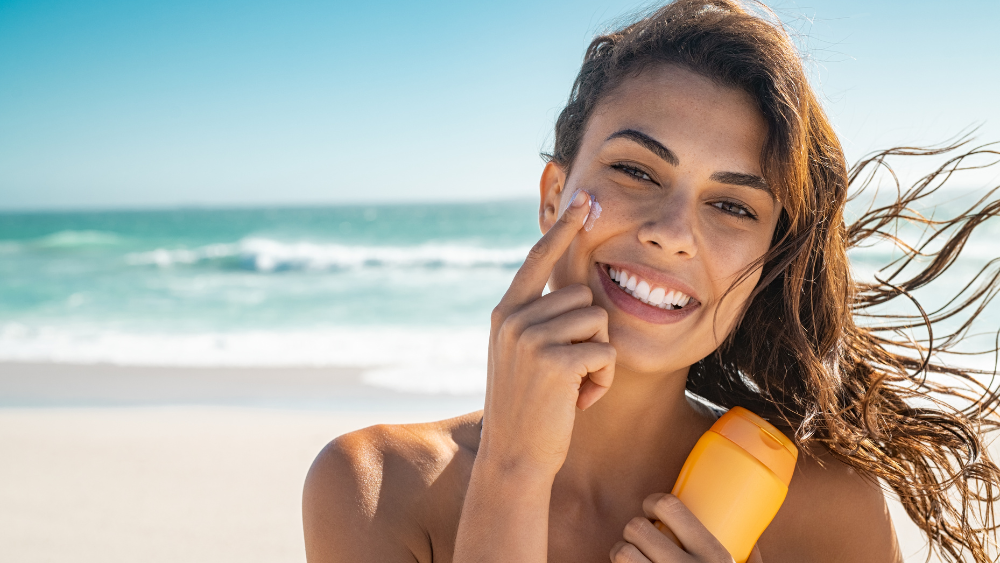Blog
Posted July 28, 2023 in Med Spa, Skincare | 4 minute read

Protect Your Skin from the Sun’s Harmful Rays
It’s summer. The dreaded Texas heat, and not to mention the intensity of the UV rays. Unknowingly, the sun’s rays can do much more harm than we may or may not realize. It is essential to keep our skin protected.
Skin Layers
Let’s first dive into the anatomy and physiology of the largest organ that makes up the human body: your skin. First, we should be aware of the three main layers of the skin. The deepest layer of your skin is called the hypodermis, where all the subcutaneous fat is stored. The next layer is called the dermis, the thickest layer of your skin and forms the actual skin, containing blood capillaries, nerve endings, sweat glands, hair follicles, and other structures necessary for the foundation of your skin. Finally, the most superficial layer is the epidermis. It is the thinnest layer and protects your deeper layers. It functions to produce new skin cells, keeps your skin hydrated, and contains melanin, which determines the color of your skin.
Ultraviolet (UV) Rays
Let’s focus on the different UV rays from the sun and environment and how they penetrate each layer of the skin to cause damage. UV rays are everywhere, and everyone is exposed to UV radiation from the sun and the environment. The sun is the most substantial source of UV, so we are focusing on the sun in this blog. There are three types of UV radiation: UVA, UVB, and UVC. They are classified according to their wavelength, biological activity, and how much they can penetrate the skin. The shorter the wavelength, the more harmful the UV radiation. The shortest wavelength, UVC, is the most damaging type of UV radiation; however, it is completely filtered by the atmosphere and does not reach the Earth’s surface. The next is medium-wavelength UVB, which cannot penetrate beyond the superficial skin layers. It is responsible for delayed tanning and burning. These short-term effects enhance skin aging and, if not protected, can promote the development of skin cancer. Finally, the relatively long wavelength UVA accounts for approximately 95 percent of the UV radiation reaching the Earth’s surface. It can penetrate the deeper layers of the skin and is responsible for the immediate tanning effect. Furthermore, it also contributes to skin aging and wrinkling.
How Do I Protect My Skin From Damage?
Choosing the proper SPF and skin protection can be overwhelming. There are so many formulas and different types of SPF out there. Let’s focus on the critical ingredients in protecting against other UV rays. 2 key functional ingredients protect our skin from UVA and UVB rays. These ingredients are Titanium dioxide and Zinc oxide. These are found in mineral sunscreen; our providers can help you find the right sunscreen. Other ingredients commonly found in sunscreen that can potentially be harmful are Oxybenzone, Avobenzone, Homosalate, Octinoxate, Octocrylene, and Octisalate, all common hormone disruptors. Other ways to protect your skin from harmful UV rays would be to wear SPF clothing to cover your skin, stay in the shade, or wear hats to help avoid direct sunlight. Especially in Texas, these UV rays can cause damage and promote skin aging. Wear your SPF!
What Can I Do to Treat My Damage Skin?
In addition to using SPF sunscreen daily, there are skincare products and treatments such as chemical peels and laser treatments that smooth fine lines, rough skin, and wrinkles, reduce the size of your pores, fade uneven pigmentation, and can promote collagen production in the dermis of the skin.
We would love to help you reach your best skincare health and encourage you to make an appointment for a consultation with one of our aesthetic PAs for advice and treatment. Call us today!
